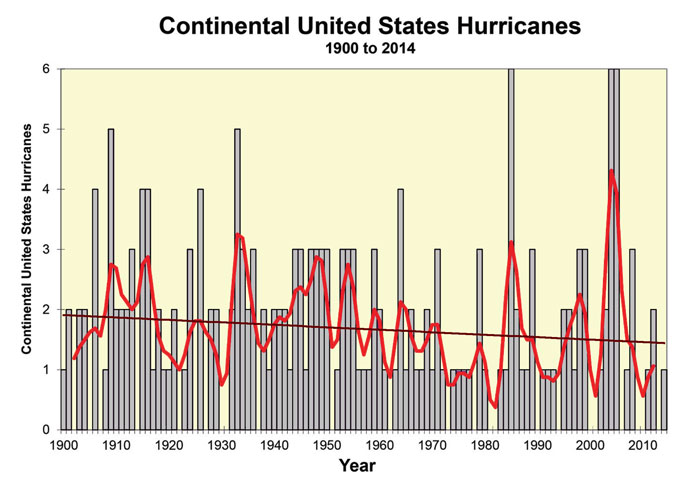| Tweet | Follow @co2science |
Paper Reviewed
Landsea. 2015. Comments on "Monitoring and Understanding Trends in Extreme Storms: State of Knowledge". Bulletin of the American Meteorological Society 96: 1175-1176.
In a Comment published in the Bulletin of the American Meteorological Society, renowned hurricane expert Christopher Landsea introduced his new work by citing the study of Kunkel et al. (2013), which provided an examination of long-term trends in storms impacting the United States. Landsea critiques the section of Kunkel et al.'s paper dealing with hurricanes as too short on a temporal time scale to provide meaningful analysis of century-scale trends (Kunkel et al.'s data presented in their Figure 5 only went back to 1970 and was based on the metric of hurricane power dissipation index). Thus, in an effort to close the knowledge gap on the subject, Landsea set forth to present "the most up-to-date record of U.S. hurricanes and the associated century time-scale trends" by revising and extending a previous hurricane analysis he performed a decade earlier (Landsea, 2005). The results of his latest efforts are depicted in the figure below.

Continental U.S. hurricanes from 1900 through 2014. The red curved line provides a 1-2-1 filter applied twice to smooth interannual variability. The dark red straight line provides the linear trend. Adapted from Landsea (2015).
As illustrated in the figure, Landsea reports "there has been a small, statistically insignificant downward trend in the frequency of U.S. hurricanes in this century-long time series," and that "the record is dominated by interannual- to decadal-scale variability." The highest frequencies were observed in the 1910s, 1930s to 1950s, mid-1980s and mid-2000s and the lowest frequencies occurred during the 1920s, 1970s to early 1980s, early 1990s, around 2000, as well as over the past few years.
Concerning the significance of these observations, Landsea reports that although the U.S. hurricane time series presented in Figure 1 represents a small portion of total hurricanes in the Atlantic basin, it nevertheless "reflects some of the same variability as seen in the whole basin." And that variability reveals, as Landsea concludes, that "there has been no long-term century-scale increase in U.S. hurricane frequencies," during which time, it might be added, there was a 100-ppm increase in atmospheric CO2 concentration.
Clearly, the 100-ppm (33%) observed increase in atmospheric CO2 over the past century has yielded no discernible impact on U.S. hurricane trends; and that observation suggests there is no compelling reason to believe future increases in CO2 will have any measurable impact either.
References
Kunkel, K.E., Karl, T.R. Brooks, H., Kossin, J., Lawrimore, J.H., Arndt, D., Bosart, L., Changnon, D., Cutter, S.L., Doesken, N., Emanuel, K., Groisman, P.Ya., Katz, R.W., Knutson, T., O'Brien, J., Paciorek, C.J., Peterson, T.C., Redmond, K., Robinson, D., Trapp, J., Vose, R., Weaver, S., Wehner, M., Wolter, K. and Wuebbles, D. 2013. Monitoring and understanding trends in extreme storms: State of knowledge. Bulletin of the American Meteorological Society 94: 499-514.
Landsea, C.W. 2005. Hurricanes and global warming. Nature 438: E11-E12, doi:10.1038/nature04477.
Posted 27 November 2015



